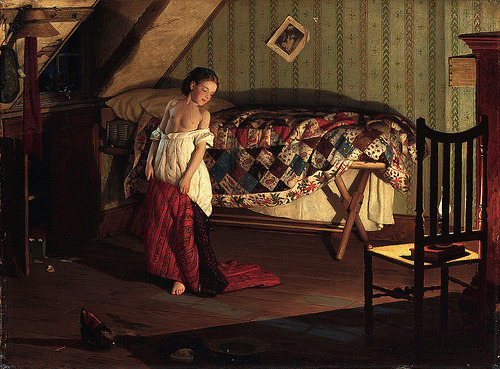There are two works of art that I will be discussing: Seymour Joseph
Guy’s Making a Train and Aleksander Rodchenko’s the Poster. Both works of
art are from two different time periods. Seymour’s Making a Train is from the 19th century whereas
Rodchenko’s the Poster is from the 20th
century. Both are depicted in two different settings because In Making a Train, Seymour depicts a child
in an intimate setting whereas in the
Poster, it’s for a public atmosphere.
Both artists use bold colors to create a sense of emotion with Rodchenko using red, black, blue, and white whereas Seymour color's are very vibrant.
In Making a Train, it’s oil on a canvas. The subject is a child who’s placed in the center of the composition as her gaze is directed away from the viewer. She is looking at herself in the mirror, which suggests she’s imagining someone else. There’s a separation of space between the child and her bed. She is semi-nude because it looks as if her garment is purposely falling off of her. Seymour creates a sense of innocence in the canvas as shadows are cast in the background.
She's alone in the attic dreaming of what she could be when she grows up. The emphasis of the clothing suggests that she's imagining being somewhere that's elegant and of high stature. The child plays with her innocence because she's aware of who she is. Seymour captures her in a promote moment that doesn't take away from her childhood.
In Rodchenko's the Poster, he incorporates big, bold letters that fill up the composition. It's on a horizontal format. He uses a mixture of photographic images that's very graphic but captures the viewer's attention at the same time. He also uses visual language to advertise a promotion through words and colors. He fills his composition with great detail and sharp diagonal lines. The women in the composition is shouting to get her message across and is in the moment.
Rodchenko was one of the most prominent of constructivism to emerge after the Russian Revolution. He used his works to create a movement of social change that needed to occur in society and created a universal language so that people could understand what he wanted to say. Both Rodchenko and Seymour depict the subjects in their works of art for a purpose. Its was to objectify them but to allow the viewer to see them in a positive way. Art was becoming more than what you saw but how you felt as a result of it.
Here's some more information on Aleksander Rodchenko:
http://www.designishistory.com/1920/aleksander-rodchenko/
Works Cited
Seymour Joseph Guy. Philadelphia Museum of Art- Collection Object: Making a Train <http://www.philamuseum.org/collections/permanent/102969.html> 2012


I appreciate the way you present the relationship between color and image. Do you feel the portrayal of woman is similar as well?
ReplyDeleteI do think the portrayal of women is similar when it comes color because when a women wears red it represents sexuality and the menstrual cycle whereas white represents purity and innocence. If a woman is depicted in a canvas with a certain color it says a lot about the image she is trying to portray because either she's being sexualized or domesticated from a man's perspective.
ReplyDelete